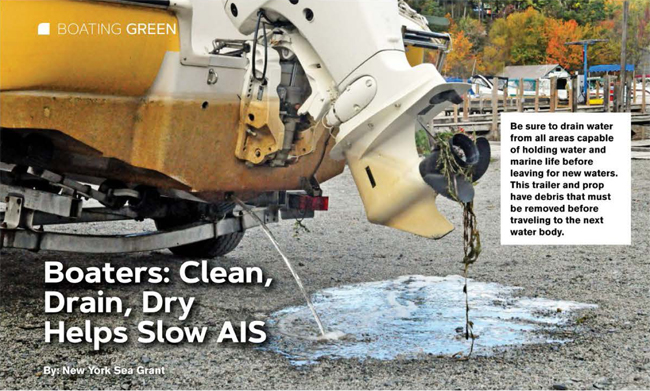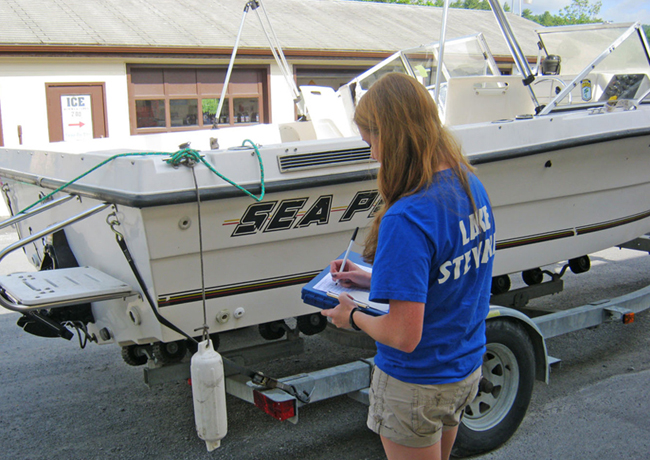— Written by Kara Dunn for Great Lakes Scuttlebutt (Summer 2019 issue)
Newark, NY, April 5, 2019 / July 1, 2019 - Following these easy watercraft inspection steps from New York Sea Grant each time you retrieve your personal watercraft or boat — large or small, motorized or non-motorized — helps slow the spread of aquatic invasive species, maintain the quality of recreational waters, and protect aquatic life habitat.
Clean: Before entering and leaving any body of water, remove any visible plants, animals, fish, and mud from your boat, trailer, or other equipment and properly dispose of it at an AIS disposal station or on dry land away from vehicle traffic and the water.
Check anywhere aquatic debris may collect from anchor and prop to intake pipes, trim tabs, seams, and sonar equipment. Don’t forget angling gear, water skis, ropes, and shoes, and, if your pet goes boating with you, give them a good inspection. Check trailers from hitch and winch to tires, wiring, rollers and license plate.
Some launch sites will have high-pressure water units for washing your boat before and after launching.
Drain: Drain water from bilge, live wells, ballast tanks, boat body, and any place capable of holding water, and microscopic organisms, before leaving the launch area.
Dry: Dry your boat, trailer, and all equipment completely. Drying times vary depending on weather and type of drying material. Dry by hand, or let vessel sit for give days to air dry, which encourages AIS die-off during the summer season.

Follow a Checklist: The How-To Tips for Slowing the Spread of Aquatic Invasive Species (pdf) published by New York Sea Grant, NOAA, and Stop Aquatic Hitchhikers includes a Watercraft Check Points checklist and illustration courtesy of the University of Wisconsin Extension Lakes.
Read the Manual: For those interested in starting a inspection steward program, the 82-page New York State Watercraft Inspection Steward Program Handbook, published by New York Sea Grant, Cornell University Cooperative Extension, and the New York State Department of Environmental Conservation, includes a steward training and field guide (pdf). Author Mary Austerman notes, “Standardizing your practices adds efficiency and effectiveness to your educational programming and assists aquatic invasive species identification and mapping.”
Report: If you find what you think may be an AIS, your state may have resources such as New York’s Partnership for Regional Invasive Species Management, for help with identifying a sample, or an AIS reporting site, such as iMapInvasives for reporting observations.
Watch the Video: See how easy Clean, Drain, Dry can be in this 7-minute Watercraft Inspection How-To produced by New York Sea Grant and the NYSG Launch Steward Program.
More on Aquatic Invasive Species at www.nyseagrant.org/ais, www.nyseagrant.org/watercraftinspection and www.nyis.info.

More Info: New York Sea Grant
New York Sea Grant (NYSG), a cooperative program of Cornell University
and the State University of New York (SUNY), is one of 33 university-based
programs under the National Oceanic and Atmospheric Administration’s
National Sea Grant College Program.
Since 1971, NYSG has represented a statewide network of integrated
research, education and extension services promoting coastal community
economic vitality, environmental sustainability and citizen awareness
and understanding about the State’s marine and Great Lakes resources.
Through NYSG’s efforts, the combined talents of university scientists
and extension specialists help develop and transfer science-based
information to many coastal user groups—businesses and industries,
federal, state and local government decision-makers and agency managers,
educators, the media and the interested public.
The program maintains Great Lakes offices at Cornell University, SUNY
Buffalo, SUNY Oswego and the Wayne County Cooperative Extension office
in Newark. In the State's marine waters, NYSG has offices at Stony Brook
University in Long Island, Brooklyn College and Cornell Cooperative
Extension in NYC and Kingston in the Hudson Valley.
For updates on Sea Grant activities: www.nyseagrant.org has RSS, Facebook, Twitter, and YouTube links. NYSG offers a free e-list sign up via www.nyseagrant.org/nycoastlines for its flagship publication, NY Coastlines/Currents, which is published quarterly. Our program also produces an occasional e-newsletter,"NOAA Sea Grant's Social Media Review," via its blog, www.nyseagrant.org/blog.